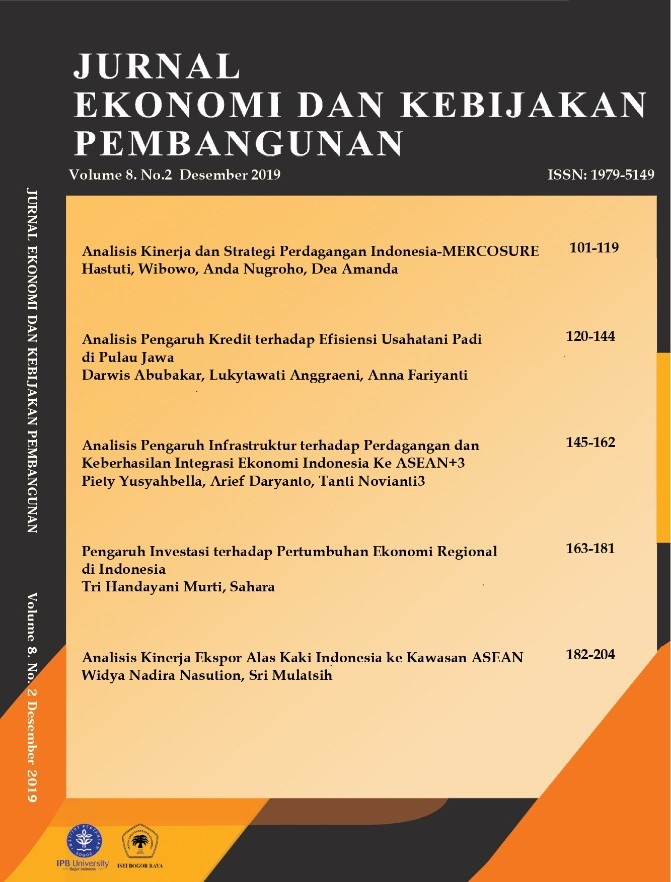Performance Analysis of Indonesian Footwear Exports to the ASEAN region IPB University
Abstract
The main export of Indonesian footwear is to the United States and several countries in Europe, while for the nearest region to Indonesia, such as ASEAN, the export value of Indonesian footwear is quite low. This study aims to analyze the competitiveness and performance of Indonesian footwear exports to the ASEAN region in 2010-2014. The partner countries in this study are Malaysia, Singapore, Thailand, the Philippines, Vietnam, and Brunei Darussalam. Competitiveness analysis is carried out using Revealed Comparative Advantages (RCA), Porter's Diamond, and Export Product Dynamic (EPD) indicators. The results of the RCA analysis show that Indonesian footwear has competitiveness in all countries except for Malaysia. The results of the Porter's Diamond model show that Indonesia has strong competitiveness in the footwear sector. The results of the EPD analysis show that the footwear export to the majority of partner countries are in falling star criteria. Furthermore, the analysis of footwear exports performance to the ASEAN region is carried out using the Gravity Model. The results of the analysis show that all variables significantly affect the footwear export performance. Indonesia's GDP per capita, economic distance, and export prices have negative effect on export performance, while GDP per capita of partner countries has positive effect. Exchange rate depreciation has positive impact on improving export performance.
References
[Aprisindo] Aprisindo. [diunduh 2017 Maret]. Tersedia pada: http://www.aprisindo.or.id/
[Antara] Antara News. [diunduh 2017 Maret]. Tersedia pada: http://www.antaranews.com/
[Beritasatu] Berita Satu. [diunduh 2017 Maret]. Tersedia pada: http://www.beritasatu.com/
[Bisnis] Bisnis Indonesia. [diunduh 2017 Maret]. Tersedia pada: http://www.bisnis.com/
[BPS] Badan Pusat Statistik [Internet]. [diunduh pada 2016 Februari]. Tersedia pada: http://bps.go.id.
[CEPII] Centre d’Etudes Prospectives et d’Informations Internationales. Geodesic Distances [Internet]. [diunduh 2016 Februari]. Tersedia pada: http://www.cepii.fr/distance/dist_cepii.zip
Firdaus M. 2011. Aplikasi Ekonometrika Untuk Data Panel dan Time Series. Bogor (ID): IPB Press.
Gujarati DN, Porter DC. 2009. Basic Econometrics, 5th edition. New York (US): McGraw-Hill.
Hakim L dan Dahalan J. 2009. The global financial crisis and economic integration : evidence on ASEAN-5 countries. Journal of Indonesian Economy and Business 24(3): 291-300.
Hanoum, FN. 2016. Analisis kinerja ekspor elektronika indonesia ke Amerika Latin [skripsi]. Bogor (ID): Institut Pertanian Bogor.
[Jawapos] Jawa Pos. [diunduh 2017 Maret]. Tersedia pada: http://www.jawapos.com/
[Kemendag] Kementrian Perdagangan Republik Indonesia. [diunduh 2017 Februari]. Tersedia pada: http://www.kemendag.go.id/
[Kemenperin] Kementrian Perindustrian Republik Indonesia. [diunduh 2017 Februari]. Tersedia pada: http://www.kemenperin.go.id/.
Kusuma RL, Firdaus M. 2015. Dayasaing dan faktor yang memengaruhi volume ekspor sayuran Indonesia terhadap negara tujuan utama. Jurnal Manajemen dan Agribisnis 12(3): 226-236.
Mankiw NG. 2007. Makroekonomi, Edisi 6. Fitria L, Imam N, penerjemah. Jakarta (ID): Erlangga. Terjemahan dari: Macroeconomics 6thEdition.
[Metro] Metro News. [diunduh 2017 Maret]. Tersedia pada: http://www.metrotvnews.com/
Oktaviani R, Novianti T. 2009. Teori Perdagangan dan Aplikasinya di Indonesia. Bogor (ID): Institut Pertanian Bogor.
Pradipta A, Firdaus M. 2014. Posisi dayasaing dan faktor-faktor yang memengaruhi ekspor buah-buahan Indonesia. Jurnal Manajemen dan Agribisnis 11(2): 129-143.
Porter M. 1990. The Competitive Advantage of Nation. New York (USA): Harvard Business Review.
Safitri, A. 2016. Posisi dayasaing dan faktor-faktor yang memengaruhi ekspor otomotif Indonesia ke negara tujuan utama tahun 2009-2014 [skripsi]. Bogor (ID): Institut Pertanian Bogor.
Salvatore D. 1997. Ekonomi Internasional. Haris M, penerjemah. Jakarta (ID): Erlangga. Terjemahan dari: International Economic.
[Sindo] Sindo News. [diunduh 2017 Maret]. Tersedia pada: http://www.sindonews.com/
[UNCOMTRADE] International Trade Statistics Database [diunduh 2017 Februari]. Tersedia pada : http://www.uncomtrade.org.
[UNCTADSTAT] United Nations Conference On Trade and Development. [diunduh 2017 Februari]. Tersedia pada: http:// www.uncomtrade.org.
Waristi FV. 2014. Religion and cultural factors in bilateral trade between Indonesia and ASEAN member countries. Jurnal Kajian Ekonomi dan Keuangan 18(2): 85-98.
[WITS] World Integrated Trade Solution. [diunduh Februari 2016]. Tersedia pada: http://wits.worldbank.org.
World Bank. [diunduh 2016 Januari – 2016 Februari]. Tersedia pada: http://www.worldbank.org
Yunia, SN. 2015. Analisis dayasaing dan faktor-faktor yang memengaruhi ekspor alas kaki Indonesia ke Amerika Latin [skripsi]. Bogor (ID): Institut Pertanian Bogor.
Zahro BA. 2013. Analisis dayasaing dan faktor-faktor yang memengaruhi aliran ekspor alas kaki indonesia di kawasan Asean dan China [skripsi]. Bogor (ID): Institut Pertanian Bogor.
Authors

This work is licensed under a Creative Commons Attribution-NonCommercial-ShareAlike 4.0 International License.
The authors who publis article(s) in Jurnal Ekonomi and Kebijakan Pembangunan have to understand and agree that the copyright of article published is owned by Jurnal ekonomi and Kebijakan pembangunan including to reproduce, distribute and sell this journal to public.





